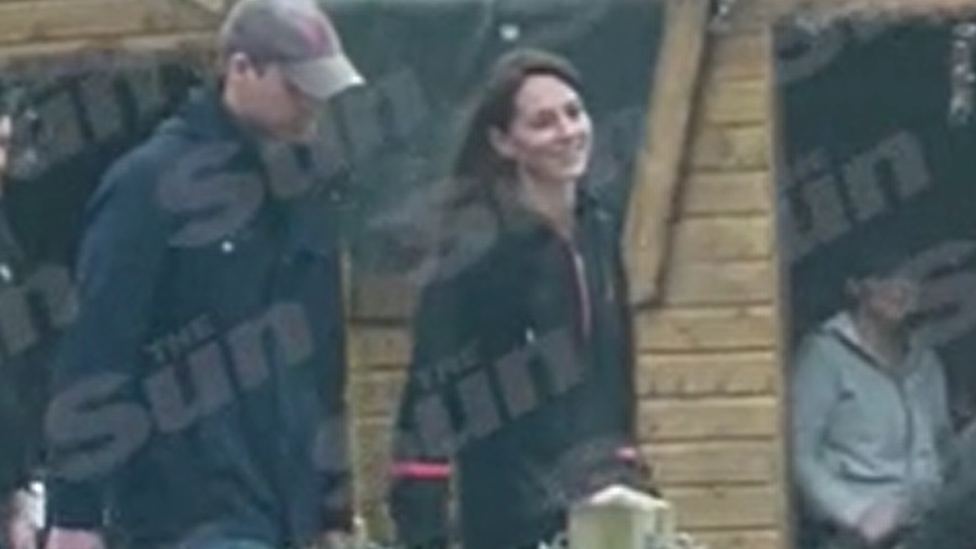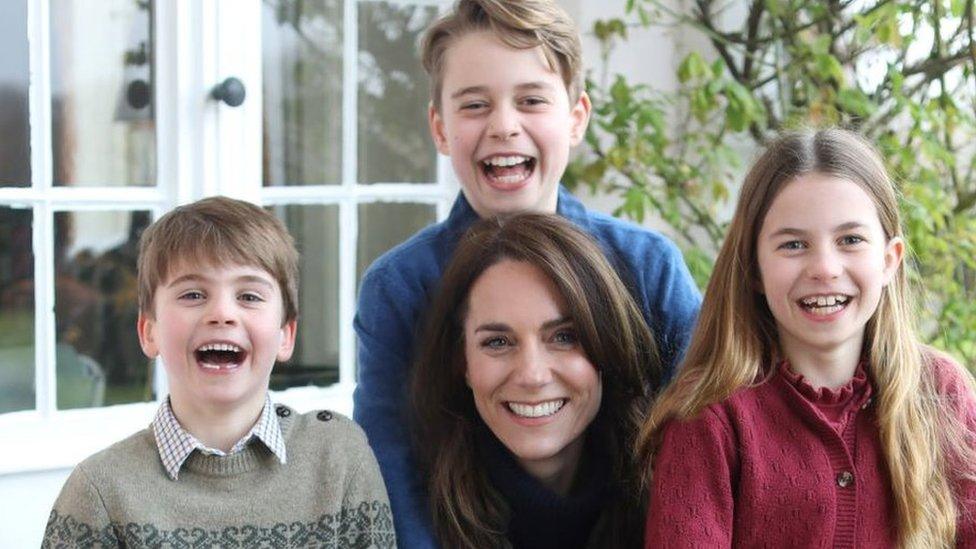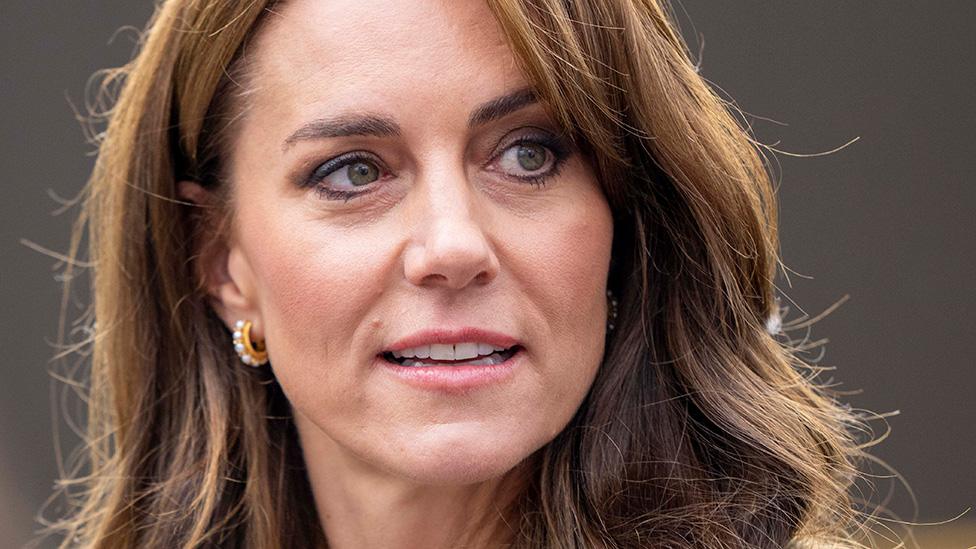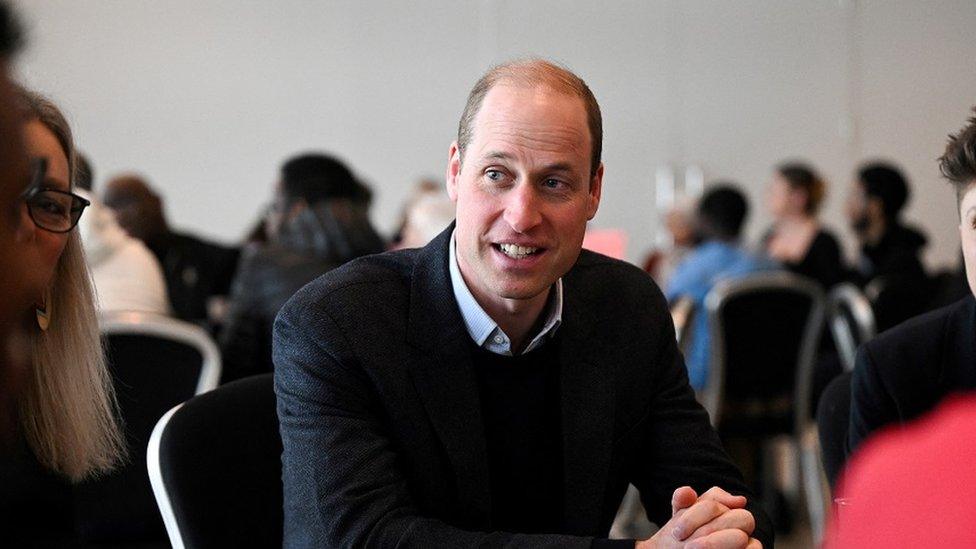How Kate body-double conspiracy theory spread on social media
- Published

The Sun published images of the Princess of Wales at a farm shop near Windsor
"It's a body-double! There's no way that's Kate!"
The first video that popped up on my social media feed this morning featured an amateur sleuth promoting a false conspiracy theory that footage of the Princess of Wales at a farm shop with her husband, published by the Sun newspaper, external, was actually of a well-known professional impersonator.
There is no evidence to suggest this is the case. It's the latest example of false theories spreading on social media about the health of Catherine.
Both genuine questions and wild claims have been triggered by her absence from public life, following abdominal surgery in January.
Kensington Palace has said the princess is recovering and is expected to return to public duties after Easter.
This social media frenzy, which the media also contributes to and which fills a vacuum of information, mirrors others that I've investigated - and that have caused serious harm to the real people at their centre.
It can cause hurt to family and friends, and more widely, it erodes public trust.
An already active social media conversation about Catherine was inflamed after it transpired a Mother's Day photo of the princess and her children, released by the Palace on social media, had been edited.
The princess later apologised and took responsibility for altering the image.

The Mother's Day photo sparked a row about editing images and was later blocked by photo agencies
There is no suggestion this new footage has been altered in any way, but it has sparked yet more conspiracy theories - and satire - all the same.
The body-double conspiracy theory, which originated on social media, wasn't just recommended on my TikTok feed.
It was also promoted to me on X, formerly known as Twitter. Both of the sites' algorithms push content based on what it thinks users might want to see.
Throughout the day, dozens of other videos and posts promoting this conspiracy theory were actively recommended to me on both my TikTok "For You Page" and my feed on X.
I found that in under 24 hours the false claims about a body-double had racked up more than 12 million views on X and more than 11 million on TikTok, according to the social media sites' own data.
Which users were sharing it?
On X, the accounts were often based in the US - and dedicated to posting about the Princess of Wales on an almost hourly basis. Several had blue ticks. These check-marks used to be given to verified accounts. Now they can be purchased in exchange for your content getting more prominence on the social media site.
I messaged dozens of TikTokers posting these videos throughout the world, many of whom were zooming in and analysing the Princess of Wales's facial features, and comparing them with those in pictures of the lookalike.

One TikToker posting from the US called Esmerelda reached 2.9 million people with her body-double video.
She told me how she hadn't posted about the Royal Family before but was motivated by "real public concern".
"I usually try to respond to people who are making claims, and summarise what's being said in general - whether I agree with the same theory or not," she told me.
"If I find out a specific theory [that] people had was definitely way off, then I never have an issue with making another video and saying: 'Hey, this theory has now been debunked and this is why.'"
Carry, a user in Germany who shared the same conspiracy theory, told me she doesn't "feel guilty" about her TikTok posts.
"In my view, the greatest good is freedom of expression, and this should also be allowed to be represented on social media."
Media outlets have also been accused of repeating and sharing evidence-free conspiracy theories posted online. But it's on social media where the content appears to be at its most extreme, and the content is reaching millions of people - far more than via the traditional media in many cases.
Despite there being no suggestion the shopping footage has been altered in any way, the sleuths continue sharing videos like this - accumulating millions of views and racking up new followers too.
According to TikTok's guidelines, the social media site does not allow "misleading, or false content that may cause significant harm to individuals or society, regardless of intent". It also previously said the site is "reducing the reach of content that advances conspiracies" about the Royal Family and other powerful groups being part of sinister plots without evidence.
X did not respond to the BBC's request for comment. It says in its guidelines that defending and respecting the user's voice is one of its core values.
- Published12 March 2024

- Published19 March 2024
